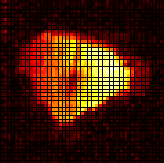MRI of Electrons
Physicists have developed nuclear magnetic resonance (NMR) as a tool to study physics and chemistry by probing nuclear spins. Today physicians use it for magnetic resonance imaging (MRI). In the 27 March PRL a team shows how the technology has now come back to physics: They used the principles of MRI to map the locations and mobilities of conduction electrons in crystals. They found a wide range of environments for the electrons, with some parts of the crystals restricting electronic motion much more than others. The technique allows the team to study electronic properties on a more microscopic scale than traditional “bulk” measures, which average properties over an entire crystal.
MRI using electron spin resonance (ESR) is similar to conventional NMR imaging, except that it probes the responses of electron spins to magnetic fields, rather than the responses of nuclear spins. With current technology, MRI is not possible with conduction electrons in metals because the so-called spin echo response to electromagnetic pulses normally decays in nanoseconds–too quick to measure. But Noam Kaplan of the Hebrew University in Jerusalem and his colleagues studied a type of organic crystal whose ESR signal lasts for microseconds, apparently related to its unusual anisotropic conductivity.
In these crystals–the radical cation salts–electrons flow essentially in one dimension, along molecular chains that span the length of the crystal (about 1 mm). In the past Kaplan and his colleagues measured electron density and mobility in the crystals using ESR, but these previous experiments produced data that were averaged over an entire crystal, despite clear indications that the crystals were not homogeneous. Inspired by his experience consulting for an Israeli medical imaging company, Kaplan suggested his students use the crystals as MRI “patients.”
The key to magnetic resonance imaging is to apply a magnetic field gradient–a field that varies with position. Since the frequency with which the nuclear or electron spins rotate depends on the strength of the local field, the location of an individual spin can be identified by the frequency of radiation it emits. Kaplan and his colleagues used field gradients in the two nonconducting directions of the crystal to get images with 30 µm resolution. In the high conductivity direction they turned on a gradient for two brief periods separated by about 10 µs–equivalent to two position measurements–as a way of determining electron mobility in that direction.
The technique gave two-dimensional maps of both electron density and mobility, with averages along the high conductivity direction in the crystals. The team found some correlations between low density and low mobility regions, possibly due to macroscopic “vacancies.” Although previous measurements showed that microscopic defects limited the electrons’ average range of motion to tens of micrometers, the new results revealed some regions where the electrons could traverse the entire crystal’s length unimpeded.
The work is “important because it [gives] a localized picture” of the electrons, rather than an averaged view, says Guenter Maresch of the National High Magnetic Field Laboratory in Tallahassee, FL. He says researchers would like a detailed understanding of the interaction of the electrons with crystal defects, in part as a model for one-dimensional conduction in nanoscale wires for molecular computers. Alex Smirnov of the University of Illinois in Urbana says ESR imaging has been applied to many areas of biology and chemistry, but the Israeli team has gotten a rare glimpse of conduction electrons by looking at these eccentric crystals. “They’ve brought ESR imaging into today’s physics.”



